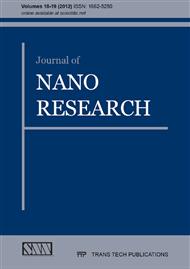[1]
S. Veprek, S. Reiprich, A concept for the design of novel superhard coatings, Thin Solid Films 268 (1995) 64-71
DOI: 10.1016/0040-6090(95)06695-0
Google Scholar
[2]
G.-S. Kim, B.-S. Kim, S.-Y. Lee, High-speed wear behaviors of CrSiN coatings for the industrial applications of water hydraulics, Surf. Coat. Technol. 200 (2005) 1814-1818
DOI: 10.1016/j.surfcoat.2005.08.059
Google Scholar
[3]
M. Diserens, J. Patscheider, F. Lévy, Improving the properties of titanium nitride by incorporation of silicon, Surf. Coat. Technol. 108–109 (1998) 241-246
DOI: 10.1016/s0257-8972(98)00560-x
Google Scholar
[4]
S. Veprek, The search for novel, superhard materials, J. Vac. Sci. Technol. A 17 (1999) 2401-2420
Google Scholar
[5]
H.C. Barshilia, A. Jain, K.S. Rajam, Structure, hardness and thermal stability of nanolayered TiN/CrN multilayer coatings, Vacuum 72 (2003) 241-248
DOI: 10.1016/j.vacuum.2003.08.003
Google Scholar
[6]
G.A. Zhang, Z.G. Wu, M.X. Wang, X.Y. Fan, J. Wang, P.X. Yan, Structure evolution and mechanical properties enhancement of A1/A1N multilayer, Appl. Surf. Sci. 253 (2007) 8835-8840
DOI: 10.1016/j.apsusc.2007.04.039
Google Scholar
[7]
J.H. Park, W.S. Chung, Y.-R. Cho, K.H. Kim, Synthesis and mechanical properties of Cr-Si-N coatings deposited by a hybrid system of arc ion plating and sputtering techniques, Surf. Coat. Technol. 188–189 (2004) 425-430
DOI: 10.1016/j.surfcoat.2004.08.045
Google Scholar
[8]
E. Martinez, R. Sanjines, A. Karimi, J. Esteve, F. Levy, Mechanical properties of nanocomposite and multilayered Cr-Si-N sputtered thin films, Surf. Coat. Technol. 180–181 (2004) 570-574
DOI: 10.1016/j.surfcoat.2003.10.121
Google Scholar
[9]
D. Pilloud, J.F. Pierson, J. Takadoum, Structure and tribological properties of reactively sputtered Zr-Si-N films, Thin Solid Films 496 (2006) 445-449
DOI: 10.1016/j.tsf.2005.09.062
Google Scholar
[10]
Y.S. Dong, Y. Liu, J.W. Dai, G.Y. Li, Superhard Nb-Si-N composite films synthesized by reactive magnetron sputtering, Appl. Surf. Sci. 252 (2006) 5215-5219
DOI: 10.1016/j.apsusc.2005.08.007
Google Scholar
[11]
Q. Liu, Q.F. Fang, F.J. Liang, J.X. Wang, J.F. Yang, C. Li, Synthesis and properties of nanocomposite MoSiN hard films, Surf. Coat. Technol. 201 (2006) 1894-1898
DOI: 10.1016/j.surfcoat.2005.12.046
Google Scholar
[12]
E. Martinez, R. Sanjinés, O. Banakh, F. Lévy, Electrical, optical and mechanical properties of sputtered CrNy and Cr1-xSixN1.02 thin films, Thin Solid Films 447–448 (2004) 332-336
DOI: 10.1016/s0040-6090(03)01113-1
Google Scholar
[13]
H.Y. Lee, W.S. Jung, J.G. Han, S.M. Seo, J.H. Kim, Y.H. Bae, The synthesis of CrSiN film deposited using magnetron sputtering system, Surface & Coatings Technology 200 (2005) 1026-1030
DOI: 10.1016/j.surfcoat.2005.02.006
Google Scholar
[14]
G. Zhang, L. Wang, S.C. Wang, P. Yan, Q. Xue, Structure and mechanical properties of reactive sputtering CrSiN films, Applied Surface Science 255 (2009) 4425-4429
DOI: 10.1016/j.apsusc.2008.11.036
Google Scholar
[15]
D. Mercs, N. Bonasso, S. Naamane, Jean-Michel Bordes, C. Coddet, Mechanical and tribological properties of Cr-N and Cr-SI-N coatings reactively sputter deposited, Surf. Coat. Technol. 200 (2005) 403-407
DOI: 10.1016/j.surfcoat.2005.02.214
Google Scholar
[16]
D. Mercs, P. Briois, V. Demange, S. Lamy, C. Coddet, Influence of the addition of silicon on the structure and properties of chromium nitride coatings deposited by reactive magnetron sputtering assisted by RF plasmas, Surf. Coat. Technol. 201 (2007) 6970-6976
DOI: 10.1016/j.surfcoat.2006.12.028
Google Scholar
[17]
T. H. Dekeijser, J.I. Langford, E.F. Mittemeijer, A.B.P. Vogels, Use of the Voigt function in a single-line method for analysis of X-ray-diffraction line broadening, J. Appl. Crystallogr. 15 (1982) 308-314
DOI: 10.1107/s0021889882012035
Google Scholar
[18]
W.C. Oliver, G.M. Pharr, An improved technique for determining hardness and elastic modulus using load and displacement sensing indentation experiments, J. Mater. Res. 7 (1992) 1564-1583
DOI: 10.1557/jmr.1992.1564
Google Scholar
[19]
A. Barata, L. Cunha, C. Moura, Characterisation of chromium nitride films produced by PVD techniques, Thin Solid Films 398 –399 (2001) 501
DOI: 10.1016/s0040-6090(01)01498-5
Google Scholar
[20]
M. Pakala, R.Y. Lin, Reactive sputter deposition of chromium nitride coatings, Surf. Coat. Technol. 81 (1996) 233-239
DOI: 10.1016/0257-8972(95)02488-3
Google Scholar


